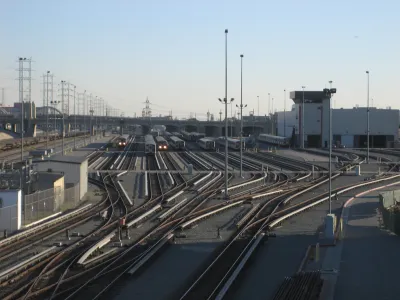Call it the Lac-Mégantic effect - the July 6 conflagration that leveled the downtown, killing 47 people, has implications for all jurisdictions where oil and freight trains run. Cities must recognize that rail insurance policies are woefully lacking.

When it comes to transporting hazardous material, rail has an advantage, perhaps more burden than blessing, over all other modes that pose significant risks for jurisdictions where the tracks are located.
Rail is the safest mode to transport these materials, which include a growing amount of crude oil and oil products. So safe that "(t)hey have a legal 'common carrier' obligation to haul cargoes that barge and truck lines can turn down," writes Betsy Morris. This testimony (page 2 of 21) in 2008 on behalf of the Secretary of Transportation elaborates on that obligation.
How safe is rail in transporting hazardous material? Curtis Tate of McClatchy's Washington Bureau explains in this Sacramento Bee article about California's preparation's to handle the more explosive Bakken crude.
The rail industry and its Washington regulators insist that railroads have a good safety record. The Association of American Railroads, an industry group, says 99.997 percent of hazardous materials shipped by rail reach their destination without incident. The Federal Railroad Administration, which oversees the nation's rail network, said 2012 was the industry's safest year on record.
The railroads are also liable for these hazardous shipments, and therein lies the problem. "There is not currently enough available coverage in the commercial insurance market anywhere in the world to cover the worst-case scenario," says James Beardsley, global rail practice leader for Marsh & McLennan Cos.' insurance brokerage unit.
Recently, “municipal leaders from Illinois, Vermont, Maine and New Brunswick toured Lac-Mégantic to assess risk to their own communities," writes Morris. "How does any community in America look at a cost like that and realistically think it can be covered? There's just no way," proclaimed Karen Darch, president of the village of Barrington, Ill.
As for who is paying the tab at Lac-Mégantic, where the clean-up cost alone is estimated at $200 million, Morris writes, "The train's operator, the Montreal, Maine & Atlantic Railway Ltd., had liability insurance of $25 million. That is about standard for a line of its size. The railroad has filed for bankruptcy protection. So far, the Canadian and provincial governments are picking up the steadily growing tab."
As bad as the devastation to Lac-Mégantic was, it was not a 'worst-case' scenario, as difficult as that may be to imagine.
"Your worst nightmare" is sabotage of a train carrying a toxic substance in a heavily populated area, says Says E. Hunter Harrison, chief executive of Canadian Pacific. "The estimates of the lives and the damage—I don't even want to repeat what it would be."
FULL STORY: Fiery Oil-Train Accidents Raise Railroad Insurance Worries

National Parks Layoffs Will Cause Communities to Lose Billions
Thousands of essential park workers were laid off this week, just before the busy spring break season.

Retro-silient?: America’s First “Eco-burb,” The Woodlands Turns 50
A master-planned community north of Houston offers lessons on green infrastructure and resilient design, but falls short of its founder’s lofty affordability and walkability goals.

Delivering for America Plan Will Downgrade Mail Service in at Least 49.5 Percent of Zip Codes
Republican and Democrat lawmakers criticize the plan for its disproportionate negative impact on rural communities.

Test News Post 1
This is a summary

Test News Headline 46
Test for the image on the front page.

Balancing Bombs and Butterflies: How the National Guard Protects a Rare Species
The National Guard at Fort Indiantown Gap uses GIS technology and land management strategies to balance military training with conservation efforts, ensuring the survival of the rare eastern regal fritillary butterfly.
Urban Design for Planners 1: Software Tools
This six-course series explores essential urban design concepts using open source software and equips planners with the tools they need to participate fully in the urban design process.
Planning for Universal Design
Learn the tools for implementing Universal Design in planning regulations.
EMC Planning Group, Inc.
Planetizen
Planetizen
Mpact (formerly Rail~Volution)
Great Falls Development Authority, Inc.
HUDs Office of Policy Development and Research
NYU Wagner Graduate School of Public Service



























